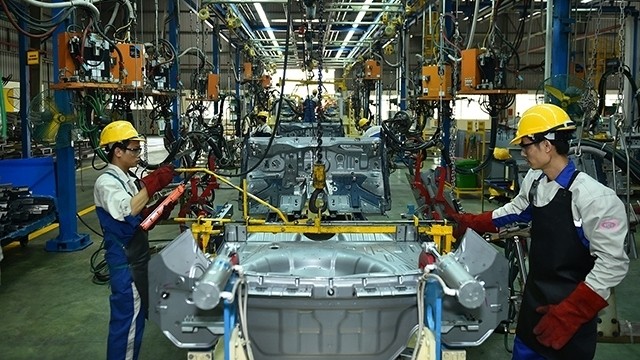High costs
By the end of 2016, Vietnam had approximately 173 enterprises manufacturing and assembling automobiles, including 56 enterprises producing automobiles from spare parts and components and 117 others assembling automobiles from completely knocked-down (CKD) automobiles with a total capacity of approximately 500,000 units per year, meeting around 70% of the domestic demand for automobiles below nine seats and passenger automobiles.
However, Vietnam’s automobile industry has yet to develop in a methodical and stable manner or meet the domestic consumption and export demand.
The shortcomings may be due to the lack of links and specialisation between automobile manufacturers and part suppliers, in addition to the lack of a system of suppliers of raw materials and components on a large scale. The high selling prices of automobiles, compared with other countries in the region, and low domestic content also causes difficulties for the automobile industry in its attempts to increase the market size in order to reduce the selling prices and compete with imported vehicles.
Chairman of the Vietnam Automobile Manufacturers’ Association (VAMA) Yoshihisa Maruta said that these inadequacies are due to the underdevelopment of Vietnam's auto supporting industry. He noted that 90% of auto part suppliers in Vietnam are foreign direct investment (FDI) enterprises and only a small number of domestic firms have participated in the supply network for automobile assembly and production.
Meanwhile, the production costs of spare parts and components in Vietnam remains higher than those imported from other countries in the region, such as Thailand and Indonesia, due to the modest market size. As a result, 75-80% of spare parts and components for domestic automotive production are currently being imported.
In addition, due to using imported components, automobile manufacturers in Vietnam have to pay additional costs such as packaging, transportation and import taxes that also contribute to raising the production costs.
Meanwhile, as of 2018, the import tax on complete-built-in (CBU) units on automobiles imported from ASEAN nations will be cut down to 0% but the import tax on components and spare parts remains higher than 0%. Therefore, the representative from VAMA said that the domestic automobile industry will find it very difficult to compete and survive, leading to the development of the auto supporting industry being impeded.
Economists have stated that if the government has determined automobile and part manufacturing as an important industry, the existing bottlenecks must be removed with the development of specific solutions and actions so that the auto supporting industry will escape from the current sluggishness.
Developing affiliate networks
A representative from the Truong Hai Auto Corporation proposed that the policies on the automobile and auto supporting industries should be synchronous and stable for at least 10 years in order to attract investors.
There should be a mechanism in place providing exemption from special consumption tax for the percentage of components produced domestically to contribute to reducing the prices of automobiles produced in Vietnam and increasing output for domestic consumers.
Meanwhile, the government should implement a policy to train hi-tech human resources for the automobile and auto supporting industries, particularly the personnel in the area of research and development towards the trend of Industry 4.0.
Furthermore, the government need to promote the role in connecting international corporations with domestic suppliers as domestic suppliers are often small and encounter difficulties in gaining direct access to large enterprises.
Other economists said that it is necessary to promote the development of the auto supporting industry aligned with increasing the domestic content of automobile production in order to boost the development of the automobile industry. Therefore, it is advisable to put forth policies to encourage automobile manufacturers to use domestic components and to reduce the corporate income tax based on the localisation rate of vehicles.
On the other hand, associations, automobile manufacturing and assembling companies and part suppliers also need to promote links and cooperation to make effective use of the available resources and consume products produced by each other for mutual development.
The Ministry of Industry and Trade has established a working group including many related sectors to make a full evaluation of the automobile market in relation to the regional and global markets. The working group has collected recommendations and opinions from auto manufacturers and has proposed solutions to support enterprises, including adjusting the policies on tax and the market, while forming a system of part suppliers along with supporting domestic automobile manufacturers to cut down on production costs, lower prices, and improve product quality.
Deputy Director of Industry Pham Tuan Anh said that one of the key solutions to develop the auto supporting industry in the future is to increase the cooperation between domestic enterprises and large foreign enterprises in the area of part supply, with the focus on increasing hi-tech content to serve the domestic demand and gradually replace imported components.
Despite facing many difficulties, statistics show that there is room for Vietnam to become one of the potential auto markets in 10 to 15 years. With the anticipated average income per capita standing at US$3000 by 2020, Vietnam is expected to enter the stage of motorisation in the 2020-2025 period, with the total demand up to 600,000 units per year by 2025. With this scale, the market will have the capacity to attract resources to develop in a stable manner.
It can be seen that Vietnam still has opportunities to develop its auto and auto supporting industries based on market pull, the driving force of technology and the support of policies which will contribute to increasing the competitiveness of the automobile industry, meeting the domestic demand and remaining prepared to integrate into the world market.
















